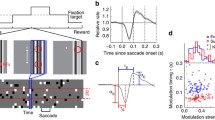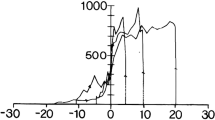Abstract
During natural activities, two types of eye movements – saccades and vergence – are used in concert to point the fovea of each eye at features of interest. Some electrophysiological studies support the concept of independent neurobiological substrates for saccades and vergence, namely saccadic and vergence burst neurons. Discerning the interaction of these two components is complicated by the near-synchronous occurrence of saccadic and vergence components. However, by positioning the far target below the near target, it is possible to induce responses in which the peak velocity of the vertical saccadic component precedes the peak velocity of the horizontal vergence component by ∼ 75 ms. When saccade–vergence responses are temporally dissociated in this way, the vergence velocity waveform changes, becoming less skewed. We excluded the possibility that such change in skewing was due to visual feedback by showing that similar behavior occurred in darkness. We then tested a saccade-related vergence burst neuron (SVBN) model proposed by Zee et al. in J Neurophysiol 68:1624–1641 (1992), in which omnipause neurons remove inhibition from both saccadic and vergence burst neurons. The technique of parameter estimation was used to calculate optimal values for responses from human subjects in which saccadic and convergence components of response were either nearly synchronized or temporally dissociated. Although the SVBN model could account for convergence waveforms when saccadic and vergence components were nearly synchronized, it could not when the components were temporally dissociated. We modified the model so that the saccadic pulse changed the parameter values of the convergence burst units if both components were synchronized. The modified model accounted for velocity waveforms of both synchronous and dissociated convergence movements. We conclude that both the saccadic pulse and omnipause neuron inhibition influence the generation of vergence movements~when they are made synchronously with saccades.
Similar content being viewed by others
References
Busettini, C, Mays LE (2003) Pontine omnipause activity during conjugate and disconjugate eye movements in macaques. J Neurophysiol 90:3838–3853
Busettini C, Mays LE (2005) Saccade-vergence interactions in macaque. II. Vergence enhancement as the product of a local feedback vergence motor error and a weighted saccadic burst. J Neurophysiol 94:2312–2330
Busettini C, FitzGibbob EJ, Miles FA (2001) Short-latency disparity vergence in humans. J Neurophysiol 85:1129–1152
Cannon SC, Robinson DA (1985) An improved neural-network model for the neural integrator of the oculomotor system: more realistic neuron behavior. Biol Cybern 53(2):93–108
Carpenter RHS (1991) The visual origins of ocular motility. In: Cronly-Dillon JR (eds) Vision and visual function. vol. 8 Eye movements. MacMillan Press, London, pp 1–10
Carpenter RHS (1988) Movements of the eyes. 2nd edn. Pion, London
Chaturvedi V, van Gisbergen JAM (2000)Stimulation in the rostral pole of monkey superior colliculus: effects on vergence eye movements. Exp Brain Res 132:72–78
Coleman T, Branch M, Grace A (1999) Optimization Toolbox for use with MATLAB, User’s Guide. The Mathworks Inc., South Natick
Collewijn H, Erkelens CJ, Steinman RM (1995) Voluntary binocular gaze-shifts in the plane of : dynamics of version and vergence. Vision Res 35:3335–3358
Das VE, Dell’Osso LF, Leigh RJ (1999) Enhancement of the vestibulo-ocular reflex by prior eye movements. J Neurophysiol 81:2884–2892
Das VE, DiScenna AO, Feltz A, Yaniglos S, Leigh RJ (1998) Tests of a linear model of visual-vesitbular interaction using the technique of parameter estimation. Biol Cybern 78:183–195
Enright JT (1984) Changes in vergence mediated by saccades. J Physiol 350:9–31
Gamlin PDR, Clarke RJ (1995) Single-unit activity in the primate nucleus reticularis tegmenti pontis related to vergence and ocular accommodation. J Neurophysiol 73(5):2115–2119
Gellman RS, Carl JR, Miles FA (1990) Short latency ocular following responses in man. Visual Neurosci 5:107–122
Gnadt JW, Mays LE (1995) Neurons in monkey parietal area LIP are tuned for eye-movement parameters in three-dimensional space. J Neurophysiol 73(1):280–297
Goldman MS, Kaneko CR, Major G, Aksay E, Tank DW, Seung HS (2002) Linear regression of eye velocity on eye position and head velocity suggests a common oculomotor neural integrator. J Neurophysiol 88:659–665
Horn AKE, Büttner-Ennever JA, Suzuki Y, Henn V (1997) Histological identification of premotor neurons for horizontal saccades in monkey and man by parvalbumin immunostaining. J Comp Neurol 359:350–363
Horn AKE, Büttner-Ennever JA (1998) Premotor for vertical eye-movements in the rostral mesencephalon of monkey and man: the histological identification by parvalbumin immunostaining. J Comp Neurol 392:413–427
Horn AKE, Büttner-Enever JA, Wahle P, Reichenberger I (1994) Neurotransmitter profile of saccadic omnipause neurons in nucleus raphe interpositus. J Neurosci 14:2032–2046
Huebner WP, Saidel GM, Leigh RJ (1990) Non-linear parameter estimation applied to a model of smooth pursuit eye movements. Biol Cybern 62:265–273
King, WM, Zhou, W (2002) Neural basis of disjunctive eye movements. Ann NY Acad Sci 956:273–283
Kumar AN, Han Y, Dell’Osso LF, Durand DM, Leigh RJ. (2005) Directional asymmetry during combined saccade-vergence movements. J Neurophysiol 93: 2797–2808
Leigh RJ, Zee DS (2006) The neurology of eye movements 4th edn. Oxford University Press, New York
Lisberger SG (1998) Postsaccadic enhancement of initiation of smooth pursuit eye movements in monkeys. J Neurophysiol 79(4):1918–1930
Maxwell JS, King WM (1992) Dynamics and efficacy of saccade-facilitated vergence eye movements in monkeys. J Neurophysiol 68:1248–1260
Mays LE (1984) Neural control of vergence eye movements: convergence and divergence neurons in the midbrain. J Neurophysiol 51:1091–1108
Mays LE (1998) Has Hering been hooked?. Nat Med 4:889–890
Mays LE (2003) Neural control of vergence eye movements. In: Chalupa LM and Werner JS (eds) The visual neurosciences vol 2. MIT Press, Cambridge, pp 1415–1427
Mays LE, Gamlin PDR (1995) A neural mechanism subserving saccade-vergence interactions. In: Findlay JM, Walker R, Kentridge RW (eds) Eye movement research: mechanisms, processes and applications. Elsevier, Amsterdam, pp 215–223
Mays LE, Porter JD, Gamlin PDR, Tello C (1986) Neural control of vergence eye movements: neurons encoding vergence velocity. J Neurophysiol 56:1007–1027
Mays LE, Zhang Y, Thorstad MH, Gamlin PD (1991) Trochlear unit activity during ocular convergence. J Neurophysiol 65:1481–1491
Ramat S, Leigh RJ, Zee DS, Optican LM (2005) Ocular oscillations generated by coupling of brainstem excitatory and inhibitory saccadic burst neurons. Exp Brain Res 160:89–106
Ramat S, Somers JT, Das VE, Leigh RJ (1999) Conjugate ocular oscillations during shifts of the direction and depth of visual fixation. Invest Ophthalmol Vis Sci 40:1681–1686
Schor CM, Lott LA, Pope D, Graham AD (1999) Saccades reduce latency and increase velocity of ocular accommodation. Vision Res 39:3769–3795
Seidman SH, Leigh RJ, Tomsak RL, Grant MP, Dell’Osso LF (1995) Dynamic properties of the human vestibulo-ocular reflex during head rotations in roll. Vision Res 35:679–689
Sparks DL (2002) The brainstem control of saccadic eye movements. Nat Rev Neurosci 3: 952–964
Sylvestre PA, Galiana HL, Cullen KE (2002) Conjugate and vergence oscillations during saccades and gaze-shifts: Implications for integrated control of binocular movement. J Neurophysiol 87:257–272
Sylvestre PA, Cullen KE (2003) Dynamics of abducens nucleus neuron discharges during disjunctive saccades. J Neurophysiol 88:3452–3468
Tabak S, Smeets JB, Collewijn H (1996) Modulation of the human vestibuloocular reflex during saccades: probing by high-frequency oscillation and torque pulses of the head. J Neurophysiol 76:3249–3263
van Gisbergen JAM, Robinson DA, Gielen S (1981) A quantitative analysis of the generation of saccadic eye movements by burst neurons. J Neurophysiol 45:417–442
van Leeuwen AF, Collewijn H, Erkelens, CJ (1998) Dynamics of horizontal vergence movements: interaction with horizontal and vertical saccades and relation with monocular preferences. Vision Res 38:3943–3954
van Opstal AJ, van Gisbergen JAM (1987) Skewness of saccadic velocity profiles: a unifying parameter for normal and slow saccades. Vision Res 27:731–745
Walton MMG, Mays LE (2003) Discharge of saccade-related superior colliculus neurons during saccades accompanied by vergence. J Neurophysiol 90:1124–1139
Yoshida K, Iwamoto Y, Chimoto S, Shimazu H (1999) Saccade-related inhibitory input to pontine omnipause neurons: an intracellular study in alert cats. J Neurophysiol 82:1198–1208
Zee DS, FitzGibbon EJ, Optican LM (1992) Saccade-vergence interactions in humans. J Neurophysiol 68:1624–1641
Zhou W, King WM (1998) Premotor commands encode monocular eye movements. Nature 393:692–695
Author information
Authors and Affiliations
Corresponding author
Rights and permissions
About this article
Cite this article
Kumar, A.N., Han, Y.H., Kirsch, R.F. et al. Tests of Models for Saccade–Vergence Interaction using Novel Stimulus Conditions. Biol Cybern 95, 143–157 (2006). https://doi.org/10.1007/s00422-006-0073-9
Received:
Accepted:
Published:
Issue Date:
DOI: https://doi.org/10.1007/s00422-006-0073-9




